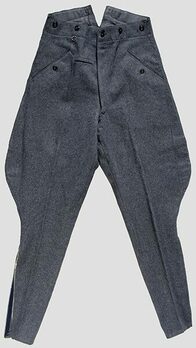Luftwaffe Senior NCO Ranks Breeches
CATEGORY: Version
SKU: 22.GOR.2300.001.00.002
Estimated market value:

Estimated market value:
The German Wehrmacht was composed of three main branches, the Heer, the Kriegsmarine, and the Luftwaffe. The Heer and Kriegsmarine uniforms were based upon the designs utilized by their predecessor organizations, the Deutsches Heer and the Kaiserliche Marine. Conversely, the Luftwaffe uniforms were based upon the uniforms worn in the sports and para-military organizations that were the forerunners of the Luftwaffe. The Luftwaffe uniforms were specifically designed to deviate from the designs of the other Wehrmacht service branches. It was also necessary that the uniforms differentiate between military and civilian pilots.
There were two main organizational precursors of the Luftwaffe, the German Air Sports Association (DLV or Deutscher Luftsportverband), and the National Air Raid Protection League (RLB or Reichs Luftschutzbund).
The DLV and the RLB were created in 1933. These civilian organizations were used to secretly train members for future roles in the Luftwaffe. The DLV became obsolete after Hitler’s official introduction of the Luftwaffe in 1935, and it was disbanded and replaced by the National Socialist Flyers Corps (NSFK or Nationalsozialistisches Fliegerkorps).
Luftwaffe personnel wore two main styles of breeches during the Third Reich, the mounted or riding breeches (Reithose), and the unmounted, regular breeches (Stiefelhose). These breeches are almost identical, only differing in the use of trimming on the seat of the breeches, the crotch, and along the inner thighs of riding breeches. The trimming is either made of leather or cloth.
These breeches were worn by Luftwaffe Generals, Officers, Officials of equivalent rank, and some Senior NCOs (Non-Commissioned Officers). They were permitted for wear as part of the service dress, undress uniform, reporting uniform, and parade uniform.
The breeches are composed of several main elements, including the cloth, the stripes, the front fly button closure, the waistband, the pockets, and the lower leg slash.
These breeches are generally composed of blue-grey wool, but breeches purchased from private manufacturers generally have a higher cloth quality. There were also breeches produced from light-weight tan/khaki coloured materials for wear in sub-tropical and tropical theatres of war, such as North Africa, Greece, and Italy.
The breeches worn by General Officers, and specific groups of Officers, feature additional cloth stripes and piping along the leg side seams. Prior to 1943, the breeches have both cloth stripes and piping. Post-1943, the cloth stripes were removed and only piping was permitting along the legs seams. The cloth stripes and piping on General breeches are white, while on Officer breeches they match the wearer’s branch of service colour (Waffenfarbe). Officers who were allowed to use stripes and piping include, but are not limited to, Engineer Corps (pink), General Staff (carmine), Building and Administration Service (black), and Officials of equivalent rank (green until 1940, white after 1940).
The waistband features exterior belt loops and interior buttons that facilitate the addition of suspenders. The exterior back of the waistband may feature a slash with buttons and an adjustable strap for sizing.
The breeches feature two horizontal “slash” pockets cut into the lining, one at hip level on either leg. There is also a fob pocket on the upper right leg and one “slash” pocket or the back right leg. Except for the fob pocket, these pockets are closed by a single plastic or horn button.
There is a vertical slash on each leg that starts right below the wearer's knee and extends to the bottom of the leg. These slashes may be closed by a zipper or by a cord passed through eyelets.
These breeches may feature a tag sewn into the interior lining with the manufacturer’s name, as well as one with the wearer’s name.

Comments
Sign in to comment and reply.


Scroll Top